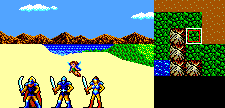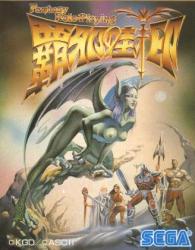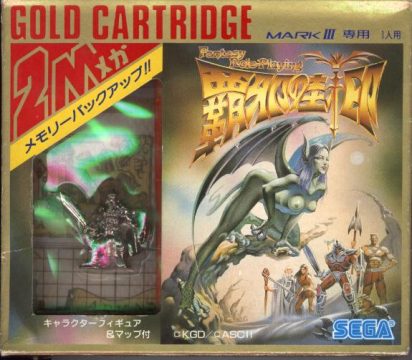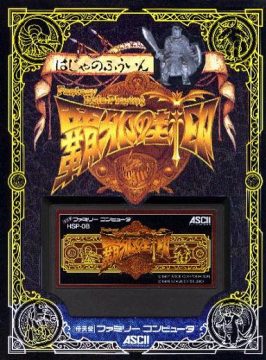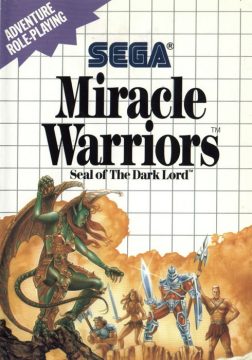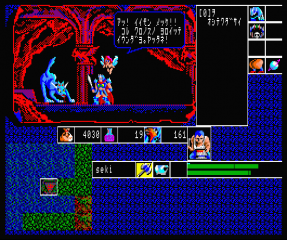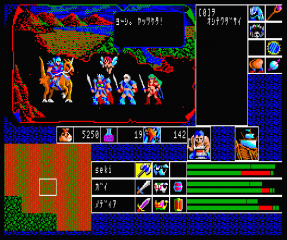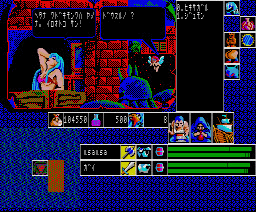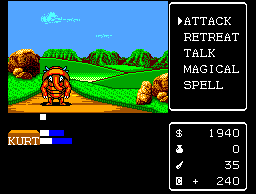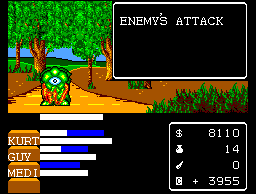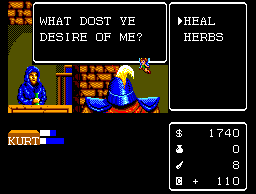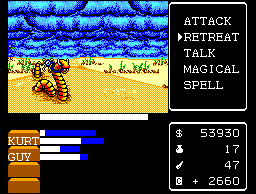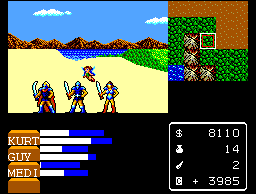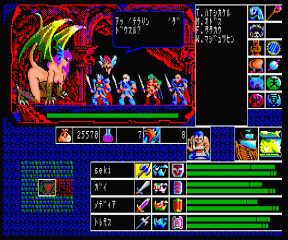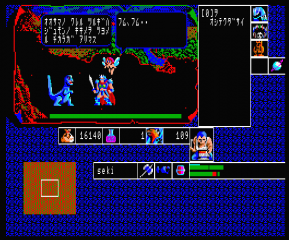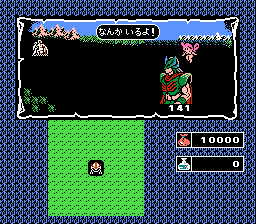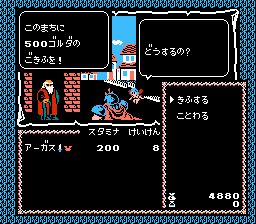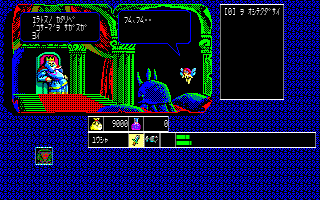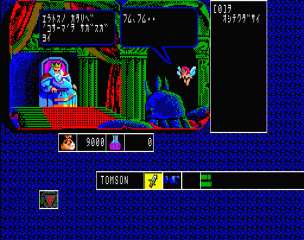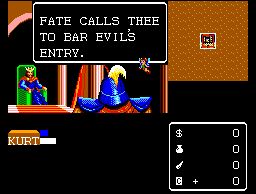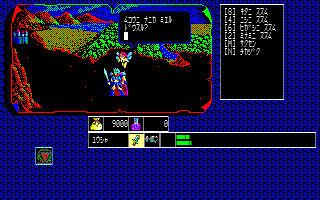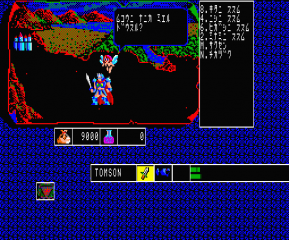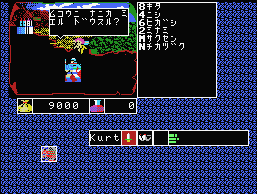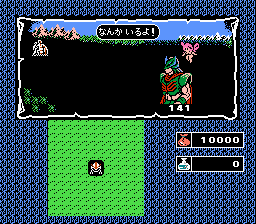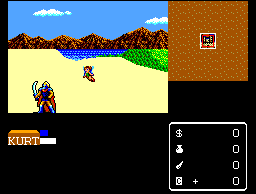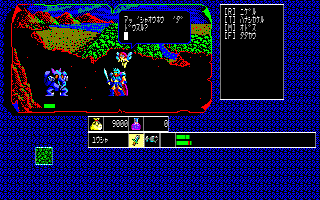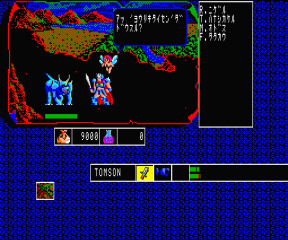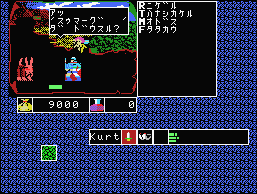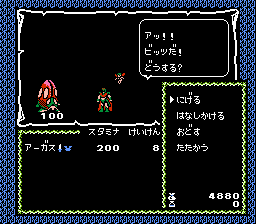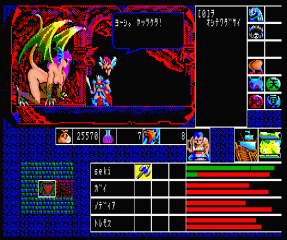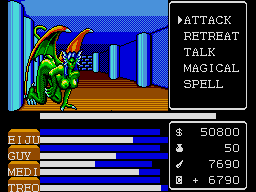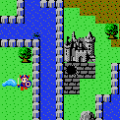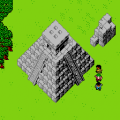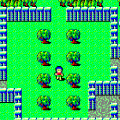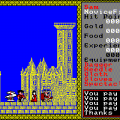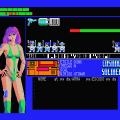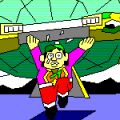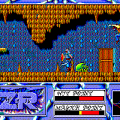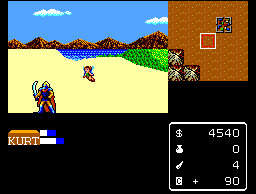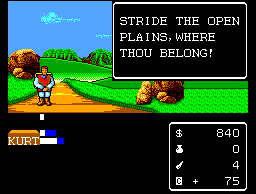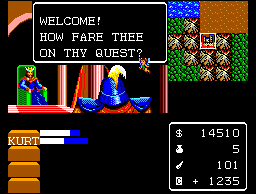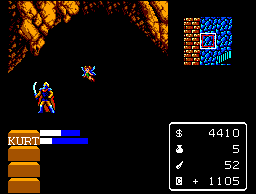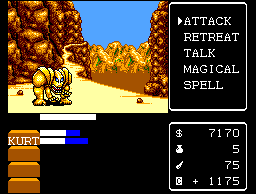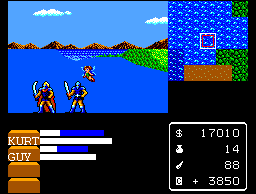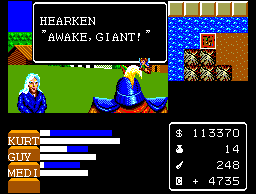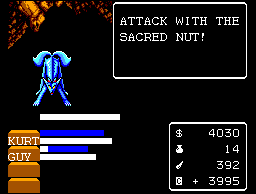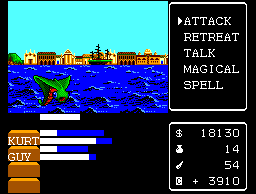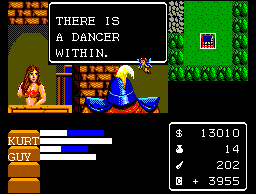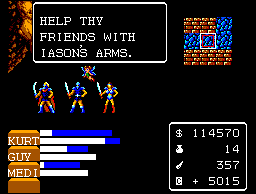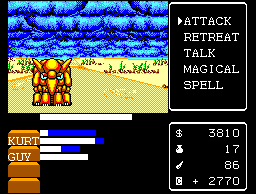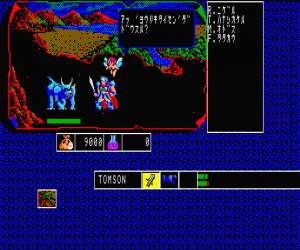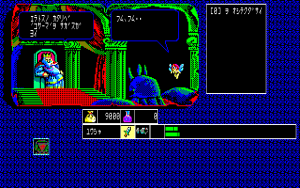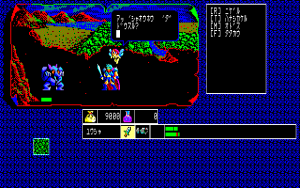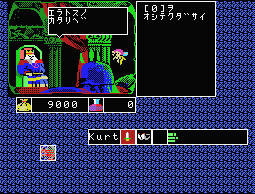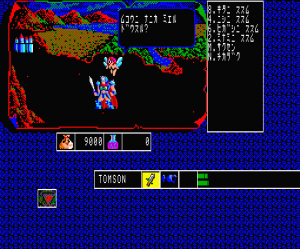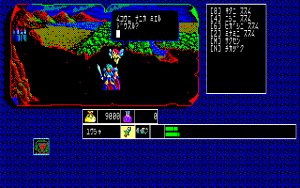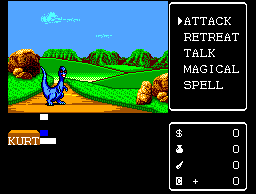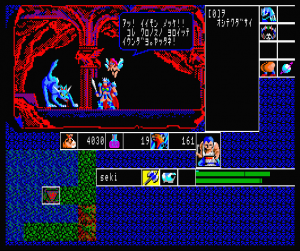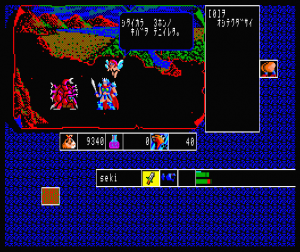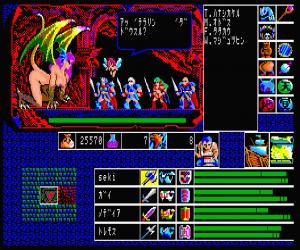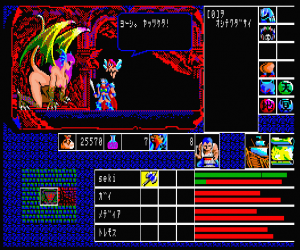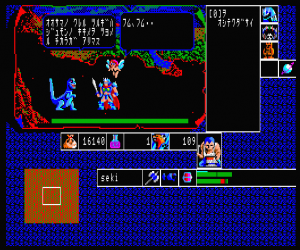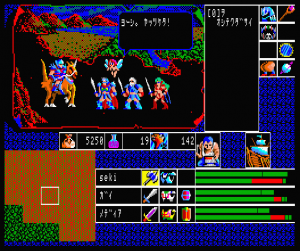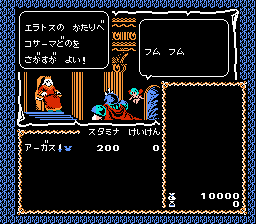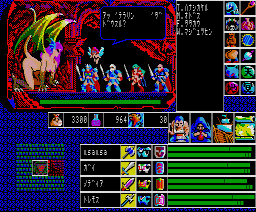Back in the mid to late 80s, the Nintendo Entertainment System was totally dominating the Sega Master System. All you had to do was look at Sega’s box covers, and it was pretty evident that they didn’t have a clue of what they were doing. The practical upside of their incompetence was that they translated practically all of their games for the English speaking audience, since their library wasn’t all that expansive to begin with. So while the executives on the Nintendo side of the fence scratched their heads in befuddlement over RPGs like Dragon Quest and Final Fantasy, Sega had already published two of their own role playing games – Miracle Warriors and Phantasy Star. Phantasy Star is rightly remembered as the best 8-bit JRPG ever made, while Miracle Warriors…well, isn’t. But it is probably the first JRPG to reach American shores, which has to be worth something from a historical standpoint.
In many ways, Miracle Warriors: The Seal of the Dark Lord (or Haja no Fuuin in Japan, which simply means “The Seal of Evil”) is actually pretty similar to the original Dragon Quest, which was released around the same time in 1986. At the beginning, you name your hero, and you speak to the king, who sits in his castle and dispenses orders to save the kingdom from evil. It seems like the Dark Lord Terarin has opened the Pandora Passage, causing monsters to roam the land. Our hero must follow the footsteps lead by the legendary hero Iason to defeat Teranin and seal the Passage. Along the way, you’ll meet three destined companions – Guy, a fearsome warrior; Medi, a female warrior who works as a dancer; and Turo (Tremos in the Japanese version), a huge, hulking axeman. It’s your standard RPG business – you walk from town to town, slaying monsters, gaining experience and gold and other items, rummaging through caverns to find mystical items and magical keys and that kind of stuff.
The big difference is the interface and presentation. Rather than giving you a full overhead view of the world map like, say, pretty much every third person RPG ever, your movement view is completed restricted to a small window in the upper right quadrant of the screen. You move a box around and only can see maybe four squares in any given direction. Most of the screen is taken up by a huge window that is supposed to represent the viewpoint of your character(s), who appear motionless, sitting on the bottom of the window frame. Whenever you move, the horizon slowly moves, giving the appearance that you’re actually moving. This was all mildly impressive back in 19886, but it doesn’t quite work, especially since the scenery doesn’t even bother to change whenever you cross through forests or mountains. The only time it does change to fit the terrain is when you buy a boat and cross over water – in which case, the ground turns a solid blue and your characters seem to be hovering on top of the ocean, Jesus-style. The bars at bottom of the screen indicates your characters’ health, along with their experience points.
Every few steps you’ll get into combat. These scenes are all completely first person, with a little menu popping on the side where you issue commands. This is all a bit like Dragon Quest, in that you only fight a single enemy at a time. Although they aren’t animated, there are some particularly cool enemy designs, and the backgrounds actually match the terrain – these the things that really showed off the enhanced color palette of the Sega Master System. Unlike Dragon Quest, you can eventually get up to four character in your party. However, instead of all four of your party members ganging up on a single monster, you’re only allowed to control one character per turn. The member you select will execute an attack, and the enemy will strike back at the attacker, until one of them is dead. The only real point to having this many party members is that you can use one character to fight, and then switch when their health gets low, since your foe will divert their attention at the new attacker. This doesn’t work all of the time though, since some bad guys have spells that will hit all of your characters anyway.
Besides this “strategy”, your battle options are fairly limited. There are magical items, some of which are impressive (staffs that causes earthquakes) and others that are not so impressive (magical nuts which you hurl at your foes, which probably would’ve looked absurd had they animated it.) These are all consumable items that are dropped by certain enemies or are bought at certain areas. But that’s about it for offense. You can’t even use healing items in the middle of battle, which proves incredibly frustrating. There is an option to Talk during encounters, where friendly faces will give a mostly useless bit of advice before trotting off. You can choose to murder them if you want and steal their gold (merchants are particularly defenseless and filled with money) but killing good guys will eventually earn you a negative reputation.
Miracle Warriors seems pretty open ended at the beginning – but wander too far and eventually you’ll come across monsters that can kill you in a single hit, a subtle warning that you’ve ventured too far of your path. Compared to Dragon Quest, which was actually fairly linear, with a defined “beginning” and “end” area, the world of Miracle Warriors is wide open, and you’ll often need to revisit various parts of the map in the later segments of the game. In fact, most of the game is spent stumbling around, vaguely interpreting hints from people, and attempting to complete your quest. When you finally meet one of your potential party members, you usually need some kind of special equipment before they’ll join you, but hell if they’ll tell you what it is or where to find it. The map that comes with the game is particularly useful in navigating, especially given the limited view range.
Beyond these required items, there’s actually a number of seemingly optional subquests that will give you extra equipment or bonus items. The only thing you can buy in the towns are standard swords, shields and armor – in order to get anything else, you’ll need to earn it. Usually you get extra weapons by trading fangs (from fallen monsters) to kings at various castles throughout the land.
And here’s where the JRPG grind comes in. You’ll need to fight a lot – not only for experience or money, but for fangs too. And battles don’t exactly speed by. There’s no way to speed through the text, which pauses for over a second whenever anything attacks. And since there’s barely any strategy outside of managing your party’s health, things drag on and on and on. It’s totally great when you finally blunder in your next destination, only to learn that you need 50,000 more guilders to buy this required item, or 300 more fangs to get a slightly less awful weapon for one of your heroes. I’m all for advocating playing retro game on their original systems, but Miracle Warriors is hugely annoying unless you’re playing on an emulator with a frame skip, in which case, the whole ordeal is a lot more digestible.
Other little quirks prove to be massive headaches – your weapons and equipment eventually deteriorate after use, so you need to go back to town every once in awhile to fix them. Thankfully, you can hire a blacksmith to follow you around so it can be done for free, but it’s still annoying. Furthermore, whenever one of your characters dies, they need to be brought to a specific town, where your charged an absurd amount of cash to bring them back to life. Don’t have the cash? Just spend another hour fighting for it! Whenever you lose a teammate, it’s just better to reload your last save game. At least you can save at most any time, and you have five whole save slots to play around with.
The English version uses silly olde English similar to Nintendo’s translation of Dragon Warrior. Some of it’s actually surprisingly well written especially considering how little space there is for text, although there are some misspellings (“Armor” becomes “Amor” in at least one spot.) There’s another weird little bit when you try to buy healing herbs – the healer quotes you the price and asks if if that’s too expensive. If you answer “no”, implying that the herbs aren’t too expensive and you wish to purchase them, but instead, you’ll just leave. You need to answer “yes” to buy them, which makes no sense on the context of the language. This would have made sense if the healer simply asked “Would you like to buy them?” like every other RPG. Amusingly, while the cover of the English version redraws the female demon (the final boss) to include clothes, her sprite remains topless in-game.
Miracle Warriors is obviously pretty archaic, even compared to Final Fantasy or Phantasy Star…but its relatively open-ended structure, visuals, and multiple party members at least put it a far step above the original Dragon Quest. It also has an excellent soundtrack, which sounds like it’s composed by the same musical geniuses at Sega who did Zillion and Phantasy Star, and it’s not too far off from the soundtracks to the early Ys titles and other Falcom games. It’s too bad that the crushing difficulty and absurd grinding (even for its time) that keeps Miracle Warriors from being more than a footnote. What’s interesting, however, is that the Sega Master System version of Miracle Warriors is actually a port/remake of an older PC game of the same name. The original game was made by a company called Kogado Software, and then Sega bought the rights to reprogram it. (The title screen mentions this, along with ASCII, the company that did the Famicom port.) These earlier versions are even more user unfriendly than Sega’s port, and in turn really makes the Master System version seem significantly superior.
The MSX and PC88 versions are superficially similar, in that the main window shows a view of the character and a shot of the landscape. However, there’s no map of your surroundings. At all. You’re basically walking around in the dark (and in silence, because there’s no music), with only a tiny little indicator telling you what kind of terrain you’re presently on. The background in the main window stays completely static. The map that came with the Sega version was a huge aid, but here, it’s literally a requirement. God help you if you lose your place on the map too. As you stumble around, you’ll occasionally wander into castles or see enemies in the distance. Unlike the Sega version, you can actually choose most of your battles, although you’ll get still randomly attacked by powerful bad guys, most of which will completely destroy you, giving you only slim chances of escaping.
All of the movement and commands are handled through the keyboard, as opposed to selecting them with menus. You also no longer walk around towns, but instead just choose different shops from a menu, which is actually a bit easier than the Sega version. Strangely enough, your fairy companion actually talks to you, announcing the names of towns and such. She still exists in the Sega version but doesn’t do much but flap her wings. Naturally, given the low power of these home computers, the graphics are all pretty bad. The MSX cart and PC88 versions are roughly equivalent, with the latter running at a higher resolutions. The MSX2 disk version has more colorful graphics, although it also adds in obnoxious load times.
Haja no Fūin was also ported to the Famicom by ASCII, which is pretty similar to the computer versions. This version adds a mini-map similar to the Sega version, although you still can’t see towns and castles or other important locations unless you’re directly on top of them. The main window is replaced with close-up views of your warriors, with battles switching to a separate screen, which resembles the computer version. In general, the graphics aren’t much better than the PC versions, and looks completely pathetic when compared to the Master System version. While the hero in the other versions is unnamed, here he has the default named of Argus. The Famicom version does have music, although again, it’s vastly inferior to the excellent soundtrack of the Sega version.
The MSX cartridge and Famicom versions both use password saves, while the disk based games (and Master System) let you save your game anywhere. The world layout in the PC/Famicom versions is completely, 100% different than the Sega game. The PC/Famicom version is also, somehow, even more remarkably difficult than the SMS version. Even the simplest of fights when equipped with your starting equipment will provide a challenge. I’ve only wandered beyond the starting section of the game, where I immediately get killed by a fire breathing dragon – it’s just ridiculously maddening. The Master System version really is more like a sequel/remake than just a mere port. It may be outdated by today’s standards, but it’s at least playable compared to the versions it was based on.
Links:
Miracle Warriors Guide Complete walkthrough.
RPG Classics English fan shrine.
Screenshot Comparisons
